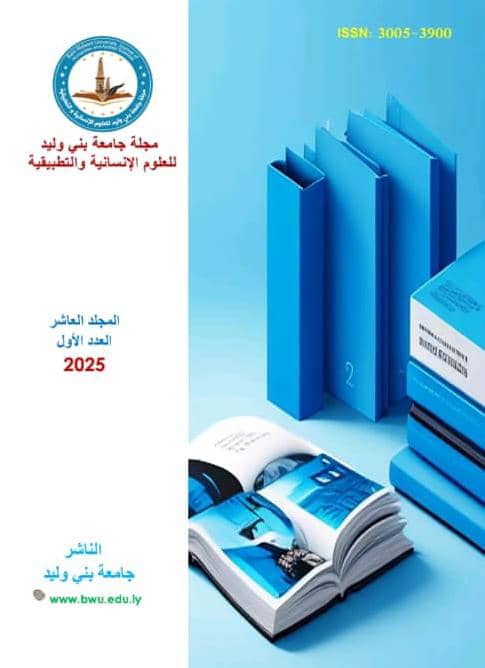Semantic fields in the introductions of the book (Al-Muwafaqat fi Usul al-Fiqh) by Imam al-Shatibi
DOI:
https://doi.org/10.58916/jhas.v10i1.682Keywords:
semantic fields, Tributaries, Shatby, approvals, introductions.Abstract
The theory of semantic fields represents a good way and an effective solution for monitoring the lexical items of any linguistic text. This theory is based on the general concepts that make up the vocabulary of the language. It shows the strength of the connection between the vocabulary of one field, and it also contributes to revealing similarities and differences, and what unites those vocabulary. Of relationships, in addition to contributing to the lexical industry that our ancestors began through the development that the language has gone through and is going through. Semantic fields are nothing but a Western name for a seed of Arabic origin that was scattered in the writings of our early scholars, such as treatises and linguistic dictionaries, which were based on dividing words according to their meanings into axes and words. The idea is Arab in rigin, and the theory is Western in approach. The study included several semantic fields in which the linguistic vocabulary within the author's text was characterized by strong interconnection, durability of communication, and clarity of meaning. Such as the semantic fields that relate to the human being, his attributes, names, organs, and senses, and the resulting obedience and monotheism to the One and Only One, and the legal rulings that are required of him, in a harmonization in which the linguistic ability of Imam Al-Shatibi was evident.
Downloads
References
Al-Masdi. Abdul Salam. (1979). Stylistics and Style, Dar Al-Arabiya for Books, Beirut.
Al-Shatibi, Abu Ishaq. Al-I'tisam. Riyadh Modern Library.
Al-Zarkali, Khair Al-Din bin Mahmoud. (2002). Al-A'lam (15th Edition), Dar Al-Ilm Lil-Malayin,. Beirut:
Bin Ashour, Al-Fadil. Al-A'lam Al-Fikr Al-Islami Fi Tarikh Al-Maghreb Al-Arabi, Al-Najah Library,. Tunis.
Al-Shatibi, Abu Ishaq. (1983). Al-Ifadat Wa Al-Inshadat (Investigation: Muhammad Abu Al-Ajfan), First Edition, Damascus.
Al-Mawqashi, Omar Ali. (Unknown). Synonymy, Verbal Co-occurrence and Antonymy: A Study of the Views of Linguists and the Reasons for Emergence. Annals of the College of Islamic and Arabic Studies for Girls in Alexandria, Issue 33.
Anis, Ibrahim. (1972). The Meaning of Words (3rd Edition) Anglo-Egyptian Library, Cairo.
Omar, Ahmed Mukhtar. Semantics, World of Books, Cairo:.
. Palmer, F. R. (1995). Semantics: A New Framework (Translated by: Sabry Al-Sayed), Dar Al-Ma'rifah Al-Jami'ah, Alexandria.
Kamal Al-Din, Hazem Ali. (2006). Comparative Semantics (1st Edition), Faculty of Arts, Sohag
Abu Al-Ajfan, Muhammad. (1985). Fatwas of Imam Al-Shatibi (2nd Edition), Al-Kawakeb Press, Tunis.
Bin Manzur, Muhammad bin Makram (n.d.). Lisan Al-Arab (1st Edition), Dar Sadir, Beirut.
Al-Ubaidi, Rashid Abdul Rahman. (2008). Studies in Linguistics and Linguistics (1st Edition)., Dar Al-Shu'un Al-Thaqafiyah Al-Amma, Baghdad.
Zouin, Ali. (n.d.). The Semantic Field between Word Books and Modern Theory. Arab Horizons Magazine, January, Year 17.
Ben Younes, Shahrazad. (2016). Lectures on the Theory of Semantic Fields and Semantic Development. University of Brothers Mentouri - Constantine.
Abu Al-Faraj, Muhammad Ahmad. (1966). Linguistic Dictionaries in Light of Modern Linguistics Studies (1st Edition), Dar Al-Nahda Al-Arabiya, Beirut.
Kahala, Omar Reda. Dictionary of Authors, Dar Ihya Al-Turath Al-Arabi, Beirut.
Al-Shatibi, Ibrahim bin Musa. (1997). Al-Muwafaqat (Investigation: Abu Ubaida Mashhour) (1st Edition), Dar Ibn Affan, Riyadh.
Al-Huwaimel, Badis. The Theory of Semantic Fields between Arab Heritage and Islamic Thought. University of Biskra.
Abdul Sattar Ahmed, Nour El-Din. (2022). The Theory of Semantic Fields in the Diwan of Bishr bin Khazim Al-Asadi. Journal of the Faculty of Arts - Qena, Issue (57).
Al-Raisuni, Ahmed. (1995). The Theory of Objectives of Imam Al-Shatibi. The Higher Institute of Islamic Thought. 22. Al-Tanbakti, Ahmed Baba. Attaining Delight in Brocade Embroidery, Dar Al-Kotob Al-Ilmiyyah, Beirut.








